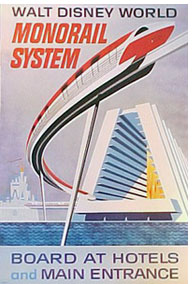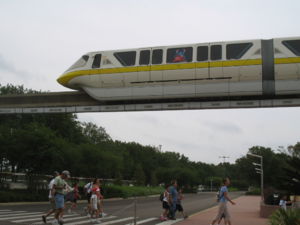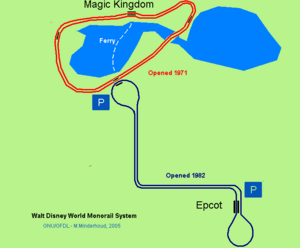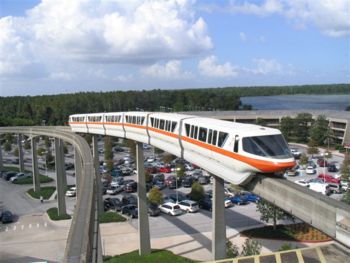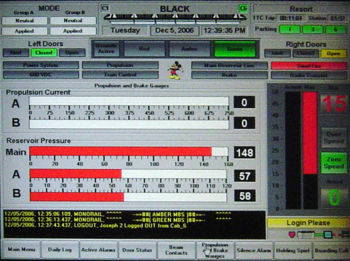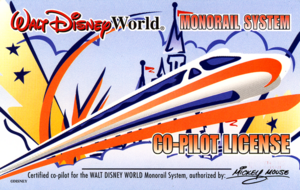Walt Disney World Monorail System
The Walt Disney World Monorail System is a monorail system for rapid transit at the Walt Disney World vacation and recreation resort in Lake Buena Vista, Florida, USA.
Contents
Introduction
One of the most famous symbols of Walt Disney World, the original Mark IV monorail was designed in California and assembled in Florida by the Martin Marietta Corporation. The new Mark VI monorails were built by Bombardier and the first of the twelve new trains (Monorail Blue) arrived to Disney property on June 8, 1989 and was installed shortly after.
Since 1971, when the loop at the Magic Kingdom was built, the monorail has traveled the equivalent distance of twenty-one trips around the world. On a typical working day, around 150,000 Walt Disney World guests travel on three routes:
- Express: Express service between the Magic Kingdom and the Transportation and Ticket Center
- Resort: Local service making stops at the Magic Kingdom, the Transportation and Ticket Center, Disney's Polynesian Resort, Disney's Grand Floridian Resort and Spa and Disney's Contemporary Resort (Picture and Video Link). Starting from the TTC, the monorail goes first to the Polynesian, The Grand Floridian, The Magic Kingdom, and the Contemporary before returning to the TTC.
- Epcot: Service between the Transportation and Ticket Center and Epcot
A spur track connects the Express and Resort lines to the maintenance shop. Another spur connects the Epcot and Express lines and is located north-east of the Transportation and Ticket Center.
The Monorail beams, which are made of concrete with a special polystyrene core to lighten their weight, came by train from Washington state. The monorail trains themselves were designed in California, but built in Orlando by the Martin Marietta Corporation.
When the Las Vegas monorail system between the MGM Grand and Bally's Resorts opened in 1995, it used two refurbished Mark IV trains that once ran at Walt Disney World. In just a few years of operation, the system had carried more than 40 million passengers along its short track. The old Mark IV cars have since been replaced with updated trains.
Terminology
Monorail cast members communicate using jargon specific to Walt Disney World.
Cast Members
The operators of a monorail train are called pilots. The Walt Disney World pilots are a separate group of operators from those who drive the resort buses and receive separate training.
One cast member acts as Monorail Central. Central controls the operation of the entire monorail system, usually by issuing instructions to pilots via radio. Central is responsible for setting up each day's operation in the morning, for handling contingencies and emergencies that occur during the day, and for moving trains off the system after all parks have closed. A cast member can act as Central only with a history of safe train operation, the ability to train other monorail pilots, and a rigorous training period during which they must successfully triage and treat simultaneous simulated emergencies. Monorail Central operates out of the glass booth at the Epcot load platform at the Transportation and Ticket Center.
The manager who oversees all monorail operations at Walt Disney World is called Monorail 1. Monorail one is a GSM that usually handles guest complaints as well as other items such as selling (redirecting guests at the base of the entrance ramps, similar to a carnival barker would sell tickets) ferry boats if there is a monorail downtime, or calling to start bus service if there is a closure, etc.
The coodinator who supervises the attendence sheet is called Monorail 4. This cast member does not wear the typical costume of maroon pants and a white shirt that the other monorail cast members wear, but instead dresses in a differnt white shirt and black pants.
The coordinator who drives pilots to the maintenance shop in the morning to start operations and who picks up pilots from the shop at night after trains have been parked is called Monorail 3. Monorail 3 is also responsible for staffing issues that arise.
Beams
Monorail cast members formerly referred to beams or monorail tracks by their physical location rather than by the type of service offered by trains on the beam. This however was changed in order to facilitate one set of nomenclature for the system:
- Resort: The resort beam is the innermost beam of the two beams encircling the Seven Seas Lagoon. The trains operating the resort beam offer local service to the Magic Kingdom resorts. Formerly known as the lagoon beam.
- Express: Express is the outermost beam circling the Seven Seas Lagoon and provides express service between the Transportation and Ticket Center and the Magic Kingdom. Formerly known as the exterior beam.
- Epcot: The Epcot beam connects the Transportation and Ticket Center with the Epcot theme park.
Stations
Monorail cast members refer to the system's stations as follows:
- Base: Base includes the platforms for both the lagoon and exterior beams at the Transportation and Ticket Center.
- Concourse: The concourse station includes the load and unload platforms for the Epcot beam at the Transportation and Ticket Center.
- Polynesian, Grand Floridian, Contemporary, Kingdom, Epcot: The stations at the Magic Kingdom resort hotels, at the Magic Kingdom, and at Epcot are named after each location. Because there is no monorail service to Disney's Animal Kingdom, cast members refer to the Magic Kingdom station simply as "Kingdom" without confusion.
Trains
The Walt Disney World Resort is currently operating twelve Mark VI trains. Each train is identified by one of the following colored stripes: black, blue, coral, gold, green, lime, orange, pink, purple, red, silver, and yellow.
The monorail train has six cars, with a control cab at the front and the rear of the train. Each car on a Mark IV train had four doors per side; each pair of doors provided access to two facing bench seats that spanned the entire width of the train. The doors were opened remotely by the pilot, using a control panel on the outside of the train, adjacent to the cab's door. There was a panel on both sides of the train, with one button for each car, which would open all the doors on that side of the car. When the train was loaded and ready to depart, each door had to be closed manually by Cast Members on the platform.
The Mark VI trains retained the same basic look as the original Mark IVs, but with many noticeable changes. Each car now has two sets of double doors on each side. The double doors open into a larger, squarish compartment with a bench seat on both sides. The newer trains are also taller to accommodate standing guests, who hold onto poles mounted near the center of each compartment. All doors are now both opened and closed remotely by the pilot. When opening, the two doors slide forward, then out, simultaneously, always remaining parallel to the train itself. However, the doors close one at a time.
As the train floor is slightly raised above the platform, a portable ramp must be used to load guests in wheelchairs. For many years, the Contemporary Resort station was not handicap-accessible. An elevator has since been added to the platform.
The train is also known around the world for its friendly advice and familiar voice used for years: "Please stand clear of the doors; Por favor manténganse alejado de las puertas." This voice belongs to Jack Wagner, "The Voice of Disneyland."
Monorail Shop
The monorail shop holds ten of the twelve Mark VI trains on its upper level (the bottom level houses the four steam locomotives that circle the Magic Kingdom). On any given night, two Mark VI trains are parked either in the Magic Kingdom station, the Epcot station or the Transportation and Ticket center station. On nights where the temperature drops below freezing, the trains will be parked inside the Contemporary resort but in practice trains can be left in any station (even on the express side of a resort station). No train will ever be left outside two nights in a row because routine maintenance is performed nightly.
Towing
Tow Train The tow train (tractor) can pull any monorail to the maintenance shop (round house) around the bend from Space Mountain. Monorail Operations at the Walt Disney World resort has 3 separate tractors that could in theory allow for the simultaneous towing of 3 different monorails.
Safety
MAPO
Safe train spacing is maintained via a moving blocklight system (MBS) installed in the cab of each train. The MBS appears in the top center of the pilot's console and looks similar to a horizontal stop light. There are three lights—green, amber, and red—and a push-button labeled "MAPO override".
Each monorail beam is dividided into blocks based upon pylon numbering. The currently illuminated color of the MBS indicates how far ahead the leading train is currently located. A green MBS shows that the leading train is 3 or more blocks ahead, amber means 2 blocks ahead, and red indicates that the next train is in the very next block. A block is roughly between 500 and 1000 feet (about 150 and 300 metres) long, although this varies. The start of each block is called a "hold point", as pilots may need to hold their trains at that location until the train ahead moves away. Guests riding in the front cab of a monorail can identify hold points by the yellow reflective tape around a pylon's number and by two yellow reflectors attached to the top outside edges of the monorail beam at that pylon.
For safety, trains must be kept at least two blocks apart during normal operation. A red MBS is also called a MAPO and indicates that train spacing has become unsafe. When a MAPO occurs, the train's on-board computer locks out the pilot's propulsion control and applies emergency brakes. The pilot cannot resume control of the train until either the MAPO clears or the pilot presses and holds the MAPO override button.
It is the pilot's responsibility to avoid a MAPO during normal operation. When the MBS switches from green to amber, this indicates that the monorail is approaching the train ahead. The pilot must stop the train before crossing into the next block of beamway and hence before the MBS switches to red. Should a pilot cross the hold point and receive a MAPO, this counts as a safety demerit against the pilot. If the pilot ever has three demerits on their record, then they will be transferred out of the monorails department and into a different role at Walt Disney World. A demerit is wiped from a record after one year.
Safety tests are performed daily to ensure that the MBS system is working properly on each train. At the direction of Monorail Central, each train will intentionally overrun a hold point to verify that a MAPO occurs and that the emergency brakes activate. Pilots perform tests in forward and reverse when bringing a train onto the system for the first time that day, and a forward test is again conducted mid-afternoon.
A MAPO will also occur when the pilot approaches a section of unpowered beam, a spurline, or a switchbeam thrown in the direction of a spurline. Pilots must engage the MAPO override when moving trains through a switch to the spurline. MAPOs occurring due to safety tests, switching, or beam power loss do not count as demerits against the pilot.
The term "MAPO" itself comes directly from Walt Disney, who formed a new company to deal with Disneyland's transportation system directly from the profits made by Mary Poppins.
Platform safety
Some stations have remotely-opened or even automated gates that bar riders from approaching the monorail track (and, thus, any approaching or departing train) until the operators have determined that it is safe to allow people to board the train. The cast member at the station should give you instructions on how to board if it is not made apparent. Other stations have manually operated gates to serve this function. In any case staying behind any yellow line and or gate, regardless if it is open or not, is probably the safest option (esp if a train is leaving or entering the station). The trains are powered by over 600 VDC, they draw this from a small rails (bus bars) running along the side of the beams. These bus bars are similar to the electrified or "third rail" of a subway trains and they are incredibly dangerous. If you drop an article and it falls into the trough or gap between the train and the station DO NOT attempt to retrieve it yourself. Alert a cast member, give a description of the article and they will contact Disney maintenance. The maintenance cast member, with power killed to the bus bars in that station, will retrieve the item for you. This is called “trough retrieval" and is fairly commonplace.
Severe weather
Monorail service can be suspended during severe thunderstorms. Should such a storm arise quickly, the trains will advance to the next available station and hold there until given the all-clear. Trains that are caught between stations can be ordered to come to a full stop and wait for the storm to pass.
Fire detection and alarm
Each Mark VI monorail train carries a fire alarm system, called "Allison", that alerts the train's pilot of a possible fire on-board the train. A collection of heat sensors throughout the train report heat levels to control units in both cabs of the monorail. The front panel of the Allison control system is visible through the rectangular cut-out in the carpeted wall panel between the pilot's chair and the left-side cab door. The system notifies the pilot of an alert via a continuous, high-pitched tone. Three different alerts are possible: trouble, pre-alarm, and alarm. Trouble indicates that a sensor is malfunctioning and is reporting no information to the control unit. Trouble indicators are frequently cleared by powering down and restarting the monorail train. Pre-alarm indicates that heat levels have risen above proper levels. Alarm indicates that heat levels have risen dangerously. In the event of an Allison warning tone, pilots read details of the alert from an LCD screen on the front panel of the control unit and immediately report that information to Monorail Central via radio.
Trains have no automatic fire suppression systems but instead carry 14 fire extinguishers distributed throughout the train. A fire extinguisher is located inside the footstep compartment at the front and rear of each of train cars. Each cab also carries a fire extinguisher beneath the pilot's seat. Each monorail platform has at least two fire extinguishers at the ends of the platform.
Emergency evacuation
Emergencies requiring train evacuation will be handled differently depending upon the location of the train and the nature of the emergency.
If a train is stopped at a station platform or at the work platform along the Epcot beam, guests can exit the train onto the platform. Exiting a train is possible even when the doors of the train cars are closed. The large rectangular window in the middle of each car is an emergency exit and can be removed from the interior of the car. A cast member outside the car can also forcibly open the rightmost door panel of the car by releasing the air pressure holding that panel closed. The air pressure release is a handle beneath the rectangular center window that is similar in appearance to a car door handle.
If a train is stopped on open beam, then guests evacuate through emergency exits located in the roof of the train. Guests open roof hatches by first removing decorative plastic from the ceiling above a bulkhead footstool and then by lifting open a hinged hatch that will flip across the bulkhead dividing two train cars. Guests evacuate to the roof by climbing through the open hatch onto the top of the train. The bulkheads separating cars are designed as firewalls that will contain a fire within a car to just that car. The open hatch allows guests in the affected car to transfer to an adjacent car where they can safely wait for evacuation by fire response crews.
If the emergency affects the entire train, then guests are evacuated to the surface of the beam. Guests again open the emergency roof hatches, but do not simply move to the adjacent car. Instead, they use a small handrail present along the top of each train car to move all the way to the front of the train. The train's pilot can attach a knotted rope to both the top and the base of the windscreen, and guests use the rope to shimmy down the windscreen to the surface of the beam. They finally start walking along the beam away from the train.
Reedy Creek Emergency Services provides fire response and rescue for the Walt Disney World Monorail System. The fire station behind the Magic Kingdom includes an all-wheel-drive fire truck specially designed for monorail rescue.
Riding tips
When entering the station, riders may ask a cast member (employee) if there is room to ride up front with the pilot. Such inquiries may be directed to another cast member who may ask the monorail pilot if there is room. There is seating room for four individuals. In the case of the Resort train, riders in the front may not be leaving at the next station and thus not all Resort train requests are honored as disputes have actually at times lead to fist fights among guests. For the other monorail lines, those riding in front must disembark at the next station. Monorail pilots may give out souvenir co-pilot licenses to guests riding in front with them or monorail specific transportation trading cards.
Toy monorail
A battery-powered miniature toy monorail is sold in numerous gift shops at Walt Disney World. As of 2007, the blue monorail is sold through stores throughout Walt Disney World. The Contemporary Resort and the "Monorail Switch Station", which closely resembles the Transportation and Ticket Center are the only accessories that are still sold[citation needed]. In the early 2000s, accessories sold included the Spaceship Earth, the Grand Floridian Station, the Polynesian Station, and a number of rides, such as the Mad Tea Party. Other Disney Theme Park playsets are sold, including Pirates of the Caribbean, Space Mountain, Spaceship Earth (new version), and Cinderella Castle, but alas, those do not react to the monorail.
See also
| Wikimedia Commons has media related to: Monorail at Disney World |
References
- Monorail Express. monorailexpress.com. Retrieved on August 2, 2006.
- Disney World Monorail. NYCSubway.org. Retrieved on August 2, 2006.
- Disney's Monorail. WDWHistory.com. Retrieved on August 2, 2006.
- WDW Monorail. bigfloridacountry.com. Retrieved on August 2, 2006.
Currently operating people mover and monorail systems in the United States |
|---|
| AirTrain Newark · Detroit People Mover · Disneyland Monorail · Jacksonville Skyway · Miami Metromover · Morgantown Personal Rapid Transit · Las Colinas APT System · Las Vegas Monorail · Seattle Center Monorail · Walt Disney World Monorail |
